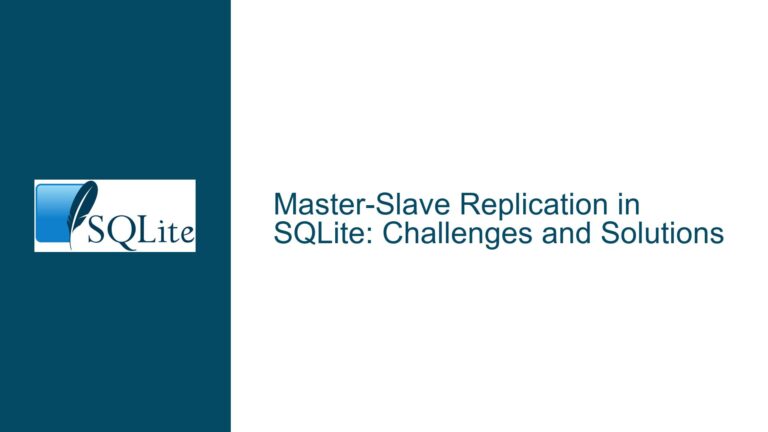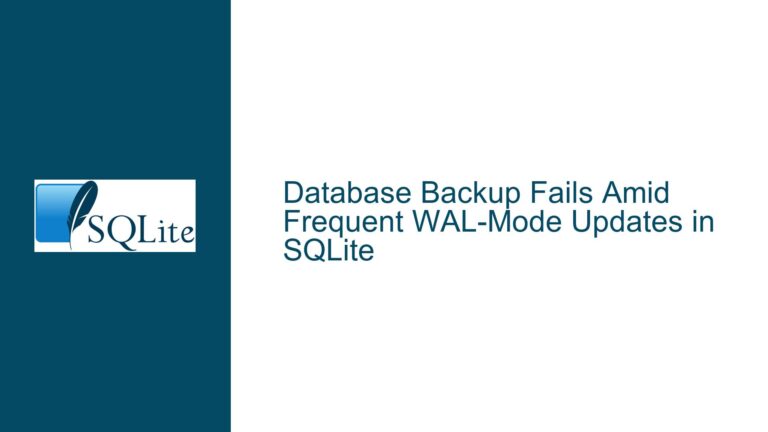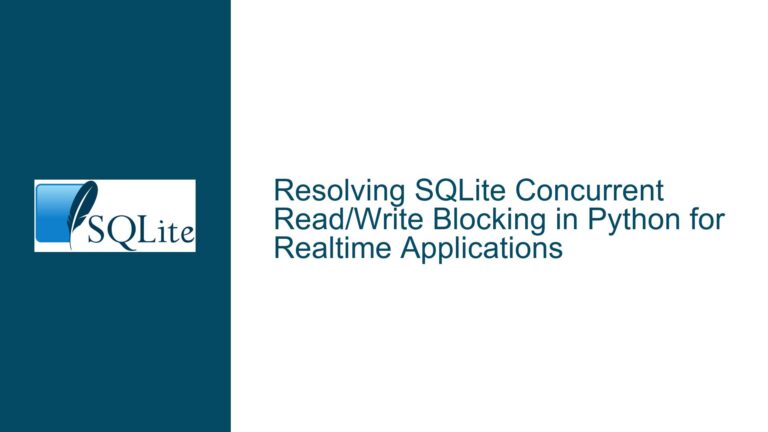Immediate Transaction Failures in SQLite on Android with WAL Mode
Transaction Deadlocks and Busy Timeout Behavior in SQLite for Android Apps
Issue: Immediate Transaction Failures Despite Configured Busy Timeout
When working with SQLite databases on Android in WAL (Write-Ahead Logging) mode, developers may encounter unexpected failures when attempting to initiate write transactions using BEGIN IMMEDIATE. These failures occur instantaneously, bypassing the configured busy_timeout value (e.g., 60 seconds). The problem manifests in multi-threaded environments where concurrent database connections interact through separate sqlite3 objects. Key characteristics include:
- Transaction initiation failure without observable wait time
- No database corruption or OS-level file locking issues
- No error codes captured initially (requires explicit error handling)
- Exclusive occurrence during write transaction attempts (
BEGIN IMMEDIATE) - Normal operation resumes after app restart or transient failures
This behavior contradicts SQLite’s documented concurrency model in WAL mode, where readers don’t block writers and writers don’t block readers. The immediate failure suggests a transaction state conflict rather than temporary resource contention.
Root Cause: Read-to-Write Transaction Upgrade Deadlocks
The core issue stems from transaction state management conflicts between concurrent database connections. SQLite employs a sophisticated locking mechanism with six lock states (UNLOCKED, SHARED, RESERVED, PENDING, EXCLUSIVE). In WAL mode, these states interact differently compared to default rollback journal mode:
Transaction Type Mismatch
A connection holding a read transaction (SHARED lock) attempting to upgrade to a write transaction (RESERVED lock) creates contention when another connection simultaneously attempts write access. This triggers an SQLITE_LOCKED (database table is locked) error immediately because:- The first connection cannot release its SHARED lock while mid-transaction
- The second connection cannot acquire RESERVED lock for writing
- Both connections enter a deadlock state unresolvable through waiting
WAL Mode Locking Nuances
While WAL mode allows concurrent reads and writes through separate files (WAL and SHM), write transactions still require sequential access to the RESERVED lock. The deadlock occurs during the lock promotion phase when multiple connections attempt simultaneous upgrades from reader to writer status.Android-Specific Factors
The Android platform introduces additional considerations:- Connection Lifetime Management: Unreleased connections during app backgrounding
- File Locking Semantics: VFS layer differences in lock acquisition
- Memory Pressure: Aggressive process killing mid-transaction
- SQLite Version Differences: Platform-specific SQLite builds with varying concurrency implementations
Resolution: Transaction Flow Optimization and Concurrency Management
Step 1: Implement Transaction State Awareness
Explicit Transaction Declaration
Replace implicit read transactions with explicit write declarations when modifications are anticipated:
-- Anti-pattern (implicit read transaction)
SELECT * FROM accounts;
-- Later upgrade attempt
BEGIN IMMEDIATE; -- Fails here
-- Correct approach
BEGIN IMMEDIATE;
SELECT * FROM accounts;
-- Perform writes
COMMIT;
Transaction Type Flagging
Maintain a transaction type flag in application code:
enum TransactionType { READ, WRITE }
void beginTransaction(TransactionType type) {
if(type == WRITE) {
db.execSQL("BEGIN IMMEDIATE;");
}
}
Step 2: Connection Pool Optimization
Single-Writer Principle
Designate a primary connection for all write operations:
object DatabaseManager {
val writerConnection: SQLiteDatabase by lazy {
createWriterConnection()
}
private fun createWriterConnection(): SQLiteDatabase {
val db = SQLiteDatabase.openDatabase(...)
db.execSQL("PRAGMA busy_timeout = 60000;")
return db
}
}
Reader Connection Isolation
Configure read-only connections with explicit parameters:
PRAGMA query_only = ON; -- Android API 16+
PRAGMA read_uncommitted = 1; -- Enable dirty reads
Step 3: Enhanced Error Handling and Retry Logic
SQLITE_LOCKED Response Protocol
Implement a staggered retry mechanism with exponential backoff:
public void safeExecuteTransaction(Runnable transaction) {
int retries = 0;
while(retries < MAX_RETRIES) {
try {
transaction.run();
return;
} catch (SQLiteException e) {
if(e.getErrorCode() == SQLITE_LOCKED) {
long delay = (long) Math.pow(2, retries) * 100;
SystemClock.sleep(delay);
retries++;
} else {
throw e;
}
}
}
throw new TransactionFailedException();
}
Connection Reset Protocol
For unrecoverable lock states:
fun resetConnection(db: SQLiteDatabase) {
db.close()
db = SQLiteDatabase.openDatabase(...)
db.execSQL("PRAGMA wal_checkpoint(TRUNCATE);")
}
Step 4: SQLite Configuration Hardening
Per-Connection Settings Validation
Ensure consistency across all connections:
PRAGMA journal_mode = WAL;
PRAGMA synchronous = NORMAL;
PRAGMA foreign_keys = ON;
PRAGMA busy_timeout = 60000; -- 60 seconds
WAL File Management
Prevent WAL file bloat through periodic maintenance:
public void performWalMaintenance(SQLiteDatabase db) {
db.execSQL("PRAGMA wal_autocheckpoint = 100;");
db.execSQL("PRAGMA wal_checkpoint(PASSIVE);");
if(db.isDatabaseIntegrityOk()) {
db.execSQL("VACUUM;");
}
}
Step 5: Android-Specific Mitigations
Lifecycle-Aware Connection Handling
Integrate with Android lifecycle components:
class SqliteConnectionLifecycleObserver(
private val db: SQLiteDatabase
) : DefaultLifecycleObserver {
override fun onPause(owner: LifecycleOwner) {
db.execSQL("COMMIT;")
db.execSQL("PRAGMA optimize;")
}
override fun onDestroy(owner: LifecycleOwner) {
db.close()
}
}
ContentProvider-Based Access
Centralize database access through Android’s ContentProvider:
<provider
android:name=".DatabaseProvider"
android:authorities="com.example.provider"
android:exported="false"
android:multiprocess="false"/>
Step 6: Advanced Diagnostics Implementation
SQLite Debug Logging
Enable extended logging through shell commands:
adb shell setprop log.tag.SQLiteStatements VERBOSE
adb shell setprop log.tag.SQLiteLock VERBOSE
Lock State Monitoring
Create a lock status monitor:
public class LockWatcher extends Thread {
private final SQLiteDatabase db;
public void run() {
while(!isInterrupted()) {
Cursor c = db.rawQuery(
"SELECT * FROM sqlite_master LIMIT 1;",
null
);
c.close();
SystemClock.sleep(1000);
}
}
}
Performance Tracing
Utilize Android’s tracing framework:
class DatabaseTracer : SQLiteTrace {
override fun onConnectionObtained(db: SQLiteDatabase) {
Trace.beginSection("DB_CONNECTION");
}
override void onSQLExecuted(
SQLiteDatabase db,
String sql,
long timeMs
) {
Trace.beginSection("SQL_" + sql.hashCode());
// Custom metrics collection
Trace.endSection();
}
}
Step 7: Transaction Flow Alternatives
Deferred Write Queue Pattern
Implement an asynchronous write queue:
public class WriteQueue {
private final Executor executor =
Executors.newSingleThreadExecutor();
public void enqueue(Runnable operation) {
executor.execute(() -> {
synchronized(writerLock) {
operation.run();
}
});
}
}
Optimistic Concurrency Control
Use version-based conflict resolution:
CREATE TABLE accounts (
id INTEGER PRIMARY KEY,
balance INTEGER,
version INTEGER DEFAULT 0
);
-- Update with version check
UPDATE accounts
SET balance = 300, version = version + 1
WHERE id = 123 AND version = 5;
Step 8: SQLite Version and Platform Validation
SQLite Feature Detection
Verify available PRAGMAs and features:
public boolean supportsFeature(String pragma) {
try (Cursor c = db.rawQuery("PRAGMA " + pragma, null)) {
return c.moveToFirst();
} catch (Exception e) {
return false;
}
}
Platform-Specific Workarounds
Handle known Android version issues:
fun applyAndroidWorkarounds(db: SQLiteDatabase) {
if (Build.VERSION.SDK_INT <= Build.VERSION_CODES.N) {
// Mitigation for Android 7.x WAL issues
db.execSQL("PRAGMA journal_size_limit = 1048576;")
}
}
Final Recommendations
Prefer Explicit Write Transactions
Always initiate transactions withBEGIN IMMEDIATEwhen write operations are anticipated, even if preceded by read operations.Implement Connection Lifetime Policies
Enforce strict connection acquisition/release patterns tied to Android components’ lifecycles.Adopt Proactive Lock Monitoring
Develop infrastructure for real-time lock state visualization and alerting.Regular WAL Maintenance
Schedule periodicCHECKPOINTandVACUUMoperations during low-activity periods.Comprehensive Error Telemetry
Capture and analyze all SQLITE_LOCKED occurrences with full context (stack traces, transaction state, and concurrent operations).
By systematically applying these solutions, developers can eliminate immediate transaction failures while maintaining SQLite’s performance advantages in Android applications. The key lies in understanding SQLite’s concurrency model nuances and adapting transaction flows to work within its constraints, rather than against them.






